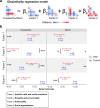Distinct neurocognitive bases for social trait judgments of faces in autism spectrum disorder
- PMID: 35292617
- PMCID: PMC8924227
- DOI: 10.1038/s41398-022-01870-9
Distinct neurocognitive bases for social trait judgments of faces in autism spectrum disorder
Abstract
Autism spectrum disorder (ASD) is characterized by difficulties in social processes, interactions, and communication. Yet, the neurocognitive bases underlying these difficulties are unclear. Here, we triangulated the 'trans-diagnostic' approach to personality, social trait judgments of faces, and neurophysiology to investigate (1) the relative position of autistic traits in a comprehensive social-affective personality space, and (2) the distinct associations between the social-affective personality dimensions and social trait judgment from faces in individuals with ASD and neurotypical individuals. We collected personality and facial judgment data from a large sample of online participants (N = 89 self-identified ASD; N = 307 neurotypical controls). Factor analysis with 33 subscales of 10 social-affective personality questionnaires identified a 4-dimensional personality space. This analysis revealed that ASD and control participants did not differ significantly along the personality dimensions of empathy and prosociality, antisociality, or social agreeableness. However, the ASD participants exhibited a weaker association between prosocial personality dimensions and judgments of facial trustworthiness and warmth than the control participants. Neurophysiological data also indicated that ASD participants had a weaker association with neuronal representations for trustworthiness and warmth from faces. These results suggest that the atypical association between social-affective personality and social trait judgment from faces may contribute to the social and affective difficulties associated with ASD.
© 2022. The Author(s).
Conflict of interest statement
The authors declare no competing interests.
Figures






References
-
- Association AP. Diagnostic and Statistical Manual of Mental Disorders. American Psychiatric Publishing; 2013.
-
- Grynberg D, Chang B, Corneille O, Maurage P, Vermeulen N, Berthoz S, et al. Alexithymia and the processing of emotional facial expressions (EFEs): systematic review, unanswered questions and further perspectives. PLoS ONE. 2012:7;e42429. https://journals.plos.org/plosone/article?id=10.1371/journal.pone.0042429. - PMC - PubMed

